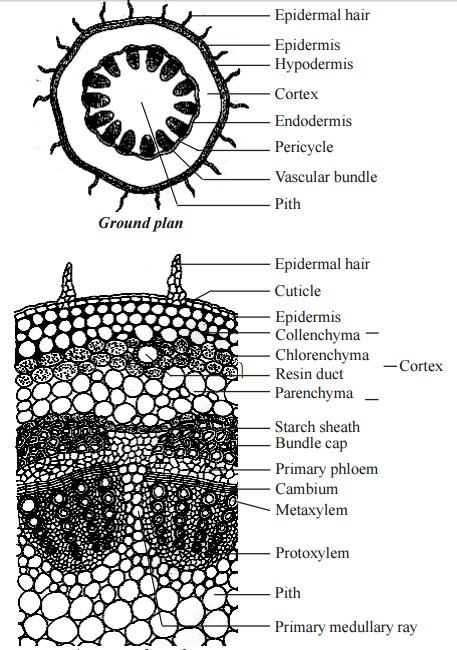Primary structure of dicotyledonous stem – Sunflower stem
Primary structure of dicotyledonous stem – Sunflower stem
Primary structure of dicotyledonous stem – Sunflower stem
Internal structure of dicotyledonous stem reveals epidermis, cortex and stele.
Epidermis
It is protective in function and forms the outermost layer of the stem. It is a single layer of parenchymatous rectangular cells.
The cells are compactly arranged without intercellular spaces. The outer walls of the epidermal cells have a layer called cuticle.
The cuticle checks the transpiration. The cuticle is made up of a waxy substance known as cutin. Stomata may be present here and there.
Epidermal cells are living. Chloroplasts are usually absent. A large number of multicellular hairs occur on the epidermis.
Cortex
Cortex lies below the epidermis. The cortex is differentiated into three zones. Below the epidermis, there are a few layers of collenchyma cells.
This zone is called hypodermis. It gives mechanical strength to the stem. These cells are living and thickened at the corners.
Inner to the hypodermis, a few layers of chlorenchyma cells are present with conspicuous intercellular spaces.
This region performs photosynthesis. Some resin ducts also occur here. The third zone is made up of parenchyma cells. These cells store food materials.
The innermost layer of the cortex is called endodermis. The cells of this layer are barrel shaped and arranged compactly without intercellular spaces.
Since starch grains are abundant in these cells, this layer is also known as starch sheath. This layer is morphologically homologous to the endodermis found in the root.
In most of the dicot stems, endodermis with casparian strips is not developed.

Stele
The central part of the stem inner to the endodermis is known as stele. It consists of pericycle, vascular bundles and pith.
In dicot stem, vascular bundles are arranged in a ring around the pith. This type of stele is called eustele.
Pericycle
Pericycle is the layers of cells that occur between the endodermis and vascular bundles.
In the stem of sunflower (Helianthus), a few layers of sclerenchyma cells occur in patches outside the phloem in each vascular bundle.
This patch of sclerenchyma cells is called bundle cap or hard bast. The bundle caps and the parenchyma cells between them constitute the pericycle in the stem of sunflower.
Vascular bundles
The vascular bundles consist of xylem, phloem and cambium. Xylem and phloem in the stem occur together and form the vascular bundles.
These vascular bundles are wedge shaped. They are arranged in the form of a ring. Each vascular bundle is conjoint, collateral, open and endarch.
Phloem
Primary phloem lies towards the periphery. It consists of protophloem and metaphloem.
Phloem consists of sieve tubes, companion cells and phloem parenchyma. Phloem fibres are absent in the primary phloem.
Phloem conducts organic food materials from the leaves to other parts of the plant body.
Cambium
Cambium consists of brick shaped and thin walled meristematic cells. It is two to three layers in thickness.
These cells are capable of forming new cells during secondary growth.
Xylem
Xylem consists of xylem fibres, xylem parenchyma, vessels and tracheids. Vessels are thick walled and arranged in a few rows.
Xylem conducts water and minerals from the root to the other parts of the plant body.
Pith
The large central portion of the stem is called pith. It is composed of parenchyma cells with intercellular spaces.
The pith is also known as medulla. The pith extends between the vascular bundles.
These extensions of the pith between the vascular bundles are called primary pith rays or primary medullary rays. Function of the pith is storage of food.
Anatomical differences between dicot stem & monocot stem
Dicot stem
1. Hypodermis is made up of collenchymatous cells.
2. Ground tissue is differentiated into cortex, endodermis, pericycle and pith.
3. Starch sheath is present.
4. Pith is present.
5. Pericycle is present.
6. Medullary rays are present.
7. Vascular bundles are open.
8. Vascular bundles are arranged in a ring.
9. Bundle cap is present.
10. Protoxylem lacuna is absent.
11. Phloem parenchyma is present.
monocot stem
1. Hypodermis is made up of sclerenchymatous cells.
2. Ground tissue is not differentiated, but it is a continuous mass of parenchyma.
3. Starch sheath is absent.
4. Pith is absent.
5. Pericycle is absent.
6. Medullary rays are absent.
7. Vascular bundles are closed.
8. Vascular bundles are scattered. in the ground tissue.
9. Bundle sheath is present.
10. Protoxylem lacuna is present.
11. Phloem parenchyma is absent.
For more details about dicotyledonous stem Click Here
Primary structure of dicotyledonous stem – Sunflower stem
Other links
Plant anatomy – Meristematic tissue
Permanent tissue , simple tissue characteristics
Complex tissues , Xylem and its Kinds
Tissue system – Epidermal,Vascular and fundamental tissue system
Primary structure of monocotyledonous root – Maize root
Structure of dicotyledonous root – Bean root
Anatomy of monocot stem – Maize stem
Anatomy of a dicot and monocot leaves

1 reply on “Primary structure of dicotyledonous stem – Sunflower stem”
Seemed as if this was the topic I wanted, but could not tell what language you were speaking most of the time. Was it a combination of English and some other?
Some words sounded like English, some like English with strange stress patterns and some, well completely unknown to me.
(Native speaker of English)